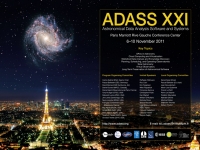William Thuillot (CNRS-Paris Observatory), W. Thuillot (IMCCE, Paris Observatory), Lainey V. (IMCCE, Paris Observatory), V. Dehant (Royal Observatory of Belgium), J.-P. De Cuyper (Royal Observatory of Belgium)J.E. Arlot (IMCCE, Paris Observatory), L. Gurvits (Joint Institute VLBI in Europe), H. Hussmann (DLR, Berlin, Germany), J. Oberst ( Tech. Univ. Berlin, Germany), P. Rosenblatt (Royal Observatory of Belgium), J.C. Marty (Observatoire Midi-Pyrénées/CNES, France), and B. Vermeersen (Tech. Univ. Delft, The Netherlands)
Abstract
The European Satellite PArtnership for Computing Ephemerides (ESPaCE) is a new EC-FP7 program which aims at strengthening the collaborative activities in the domain of the development of ephemerides and reference systems for natural satellites and spacecraft. This program started in June 2011 for a 4 year duration. For this program, teams from seven European institutions (IMCCE, ROB, TUB, JIVE, DLR, CNES, TUD) convened to get benefit from their mutual expertises in order to reach a better knowledge of the dynamics and physics of natural satellites and of spacecraft motions. For these goals, this consortium will deal with the extraction and analysis of astrometric data from observations by spacecraft not yet applied to dynamic solutions. Such data will be combined with ground-based astrometry in order to improve constraints on the dynamics and the physics of the objects. Improved ephemerides for natural satellites and spacecraft and characterization of rotation properties of selected satellites will be provided. But the consortium intends also to investigate new technologies in particular VLBI and Laser Ranging (LR) techniques. Another important part of the project will consist in merging (for the first time in Europe) for natural satellite astrometry data and spacecraft data in a global inversion. All the results and documents will be made available using standard formats (VO standard, SPICE kernels) for the use by space agencies, planetary scientists, or the public.
1. Methodology and deliverables:
Several work packages (WP) will permit to perform this work. WP2 will be devoted to the radioscience data, WP3 will deal with the Laser Ranging method for spacecraft tracking; WP4 is dedicated to the VLBI investigation to be applied to the spacecraft tracking and planetary positioning, WP5 will concern the digitizing of old photographic observations of natural satellites; WP6 concerns the astrometry and will allow us to get and format the accurate astrometric data from several sources to make them ready to be used in the models; WP7 aims at determining a shape and gravity model for the Martian satellite Phobos, establishing coordinate systems for Phobos, the Moon and the icy satellites and developing a rotation model for the natural satellites; WP8 is dedicated to spacecraft and natural satellite ephemerides and aims at providing dynamics models of natural satellites and orbits of spacecraft by exploiting of the astrometric data issued from the other WPs, ephemerides are issued from these models; WP9 aims at setting up standard public reservoirs for the data issued from the other WPs: astrometric data, rotation data, topography, ephemeris SPICE kernels; WP 10 aims at setting up standard methods and tools to access the databases in the frame VO or SPICE contexts; and WP11 on Education and Outreach aims at developing web pages, educative tools and documents, related to the whole activities and results of the ESPaCE proposal.
2. Collaborations foreseen
At first, strong collaborations will be reinforced between the co proposers of this ESPaCE project. Each of these partners have high expertise in specific and complementary domains and this project is the opportunity to enhance this expertise and apply it to the setting up of a European laboratory network in the domain of the dynamics and ephemerides, useful for example for the future space missions. But particular collaborations are foreseen with external experts, out of Europe, in particular with N. Emelianov from Sternberg Astronomical Institute (SAI, Russia), D. Pascu from the United States Naval Observatory (USNO, USA), Cheng Li Huang from Shanghai Observatory (SHAO, China), L. Zelenyi, A. Zakharov, N. Eismont, and V. Nazarov, from the Space Research Institute of the Russian Academy of Sciences (IKI, Russia), C. Murray and N. Cooper, from Queen Mary College (UK). Obviously we will have also collaborations with space agencies (ESA, DLR and CNES) and space mission teams in particular for the access to some space data. Annual workshops are foreseen in order to have exchanges between the consortium partners and with invited researchers and external experts.
3. Expected scientific and technological results
In practice we will deliver several useful data and reports concerning in particular: performances of the Laser Tracking and VLBI technology, digitized images of USNO planetary photographic plates and astrometric analysis for Mars, Jupiter, Saturn, Uranus satellites, accurate ephemerides of these satellites and orbits of the space probes which gave space images of these satellites, rotation data of Phobos, report on icy satellites control point networks, shapes and coordinate systems. The main expected scientific results of the ESPaCE project will be new dynamical models of several natural satellites and new orbits of spacecraft derived from the natural satellite space observation analysis. By combining space and gPoster in PDF format
Paper ID: P153
Poster Instructions
|

